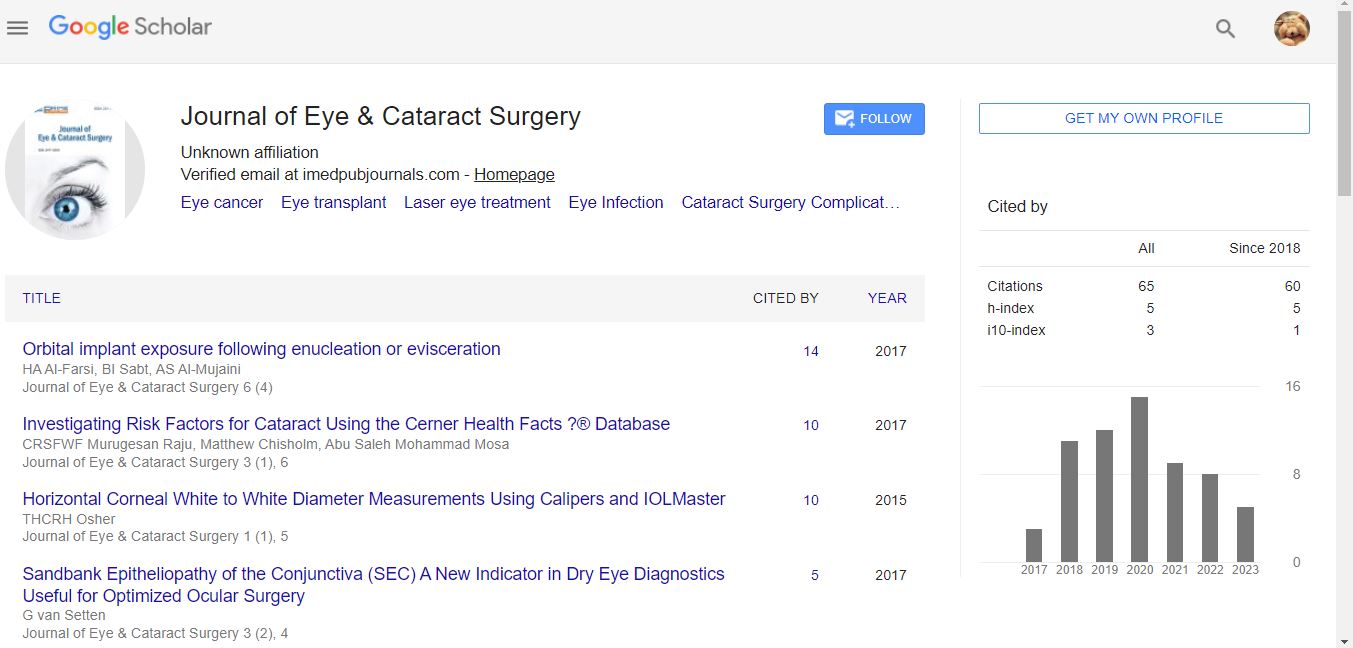Commentry - (2024) Volume 10, Issue 1
The Vitality of the Vitreous: Navigating the Depths of Ocular Anatomy
Joshuva Jones*
Department of Ophthamology, New York University, USA
*Correspondence:
Joshuva Jones,
Department of Ophthamology, New York University,
USA,
Email:
Received: 28-Feb-2024, Manuscript No. IPJECS-24-19533;
Editor assigned: 01-Mar-2024, Pre QC No. IPJECS-24-19533 (PQ);
Reviewed: 15-Mar-2024, QC No. IPJECS-24-19533;
Revised: 20-Mar-2024, Manuscript No. IPJECS-24-19533 (R);
Published:
27-Mar-2024, DOI: 10.36648/2471-8300.10.1.06
Description
Within the intricate realm of ocular anatomy lies a transparent,
gel-like substance known as the vitreous humor. Often
overlooked but undeniably essential, the vitreous plays a
multitude of roles in maintaining the structure, stability, and
optical clarity of the eye. Join us on a journey as we explore the
complexities of the vitreous, unraveling its anatomy, functions,
and clinical significance. The vitreous humor is a clear, gellike
substance that fills the space between the lens and the
retina, comprising approximately 80% of the eye’s volume.
Composed predominantly of water, collagen fibers, hyaluronic
acid, and various proteins, the vitreous possesses a delicate yet
resilient structure. It is enclosed within a thin, semipermeable
membrane called the hyaloid membrane, which serves to
contain and stabilize its composition. One of the primary
functions of the vitreous is to maintain the shape and structural
integrity of the eye. Acting as a supportive scaffold, the vitreous
provides internal pressure that helps to counterbalance the
intraocular pressure exerted by the aqueous humor in the
anterior chamber. This pressure equilibrium is crucial for
preserving the shape of the eye and ensuring optimal optical
properties for vision. The vitreous plays a vital role in facilitating
the transmission of light through the eye, contributing to visual
acuity and image formation. Its transparent nature allows light
rays to pass through unimpeded, ensuring that they reach
the retina without distortion or scattering. By minimizing light
scattering and aberrations, the vitreous helps to maintain optical
clarity and enhance visual perception. Beyond its structural
and optical functions, the vitreous provides crucial support for
the delicate layers of the retina. It helps to anchor the retina
in place, ensuring that it remains in close proximity to the
underlying choroid and retinal pigment epithelium. Conditions
such as vitreous degeneration, vitreous hemorrhage, and
vitreoretinal traction can cause symptoms ranging from floaters
and flashes to vision loss and retinal detachment. Additionally,
vitreous opacities or abnormalities may obscure vision and
interfere with daily activities, necessitating prompt medical
evaluation and management. Treatment strategies for vitreous
conditions may vary depending on the underlying pathology
and may include observation, pharmacological interventions,
or surgical procedures such as vitrectomy. Advancements in
imaging technology and surgical techniques hold promise for
the development of innovative diagnostic and therapeutic
approaches for vitreous disorders. High-resolution imaging
modalities, such as spectral-domain and swept-source, enable
detailed visualization of vitreous morphology and pathology,
facilitating accurate diagnosis and treatment planning.
Additionally, ongoing research into novel pharmacological
agents and minimally invasive surgical interventions aims to
improve outcomes and enhance patient care. In the intricate
tapestry of ocular anatomy, the vitreous emerges as a dynamic
and indispensable component, contributing to the structure,
stability, and optical clarity of the eye. From its transparent gellike
composition to its essential role in supporting the retina, the
vitreous embodies the delicate balance of form and function
within the ocular system. As our understanding of vitreous
anatomy and pathology continues to evolve, so too does our
ability to unlock new avenues for preserving ocular health and
optimizing visual outcomes.
Acknowledgement
None.
Conflict Of Interest
None.
Citation: Jones J (2024) The Vitality of the Vitreous: Navigating the Depths of Ocular Anatomy. J Eye Cataract Surg. 10:06.
Copyright: © 2024 Jones J. This is an open-access article distributed under the terms of the Creative Commons Attribution Li�cense, which permits unrestricted use, distribution, and reproduction in any medium, provided the original author and source
are credited

